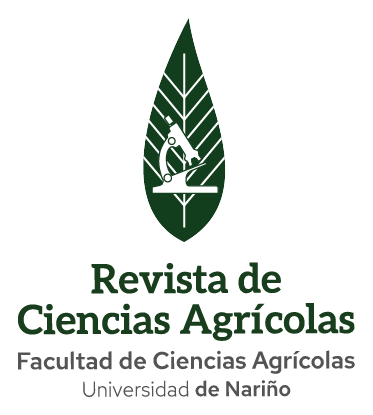Evaluación y transferencia de tecnología para tres genotipos promisorios de quinua dulce (Chenopodium quinoa Willd) en los municipios de Pasto y Guaitarilla del departamento de Nariño
Keywords:
CIAL, genotipo, quinua, genotype, quinoa.Abstract
El trabajo se llevo a cabo entre los meses de septiembre a febrero de 2005-2006, con el objetivo de realizar la evaluación y transferencia de tecnología de tres genotipos promisorios de quinua dulce en los municipios de Pasto y Guaitarilla. El proyecto inicia con la conformación de un Comité de Investigación Agrícola Local (CIAL), donde la comunidad participa en la formulación, evaluación y desarrollo de la investigación, se trabajo las variables con un diseño experimental de bloques completos al azar con arreglo de parcelas sub-divididas, donde se estudio como tratamientos, tres genotipos de quinua, (la línea SL 47, Tunkahuan y Blanca de Jericó), los subtratamientos, densidades de siembra (7, 8 y 9 kg/ha), y sub-subtratamientos distancias de siembra (30, 40 y 50 cm).
Las variables evaluadas fueron ciclo de vida, fisiología de la planta, componentes de rendimiento y reacción al mildeo velloso; Se realizo un análisis de varianza con pruebas de significancia de Tukey (0.05%). Para evaluar la aceptación de la transferencia de tecnología, se determino con el compromiso de asistencia e interés por parte de los participantes.
La formación del CIAL fortaleció las capacidades para el análisis del entorno, su problemática y la toma de decisiones, con el fin de plantear soluciones a los problemas que pudiesen presentarse. La vinculación de los agricultores en el análisis de los resultados es de suma importancia, se obtuvo resultados certeros y adecuados para las zonas de estudio, al ser el agricultor un participante directo se asegura la aceptación y óptimos resultados de la investigación.
Dentro de los resultados agronómicos, el ciclo de vida vario de 124 a 170 días siendo el factor material el mas influyente. La altura de planta varia entre 87 a 122 cm, longitud de panoja entre 23 a 27 cm se obtuvo un promedio entre 9.8 y 10.11 gramos por panoja, el rango de peso de 1000 granos fue de 2.9 y 3.8 g. el mejor rendimiento lo presento la línea SL 47 con promedios de 2393.3 kg/ha. La densidad y distancia que mejor se destacaron fueron la de 8 kg/ha a 40 cm ya que presento el mejor comportamiento en todas las variables.
ABSTRACT
This research study was carried out during the months between September and february, 2005-2006, with the goal of completing the evaluation and technology transference of three promising genotypes of sweet quinoa in the municipalities of Pasto and Guaitarilla. The committee determined to work on the variables of an experimental design of complete blocks at random with sub-divided plots, where some treatments were carried out: I) three quinoa genotypes were studied (those corresponding to the line SL 47, Tunkahuan and Blanca de Jerico), 2) the sub-treatments (planting densities 7, 8 and 9 kg/ha), and 3) sub-sub-treatments corresponding to planting distances 30, 40 and 50 cm.
An analysis of variance with evidence of Tukey significance (0.05%) was done. To evaluate the acceptance of the technology transference, it was determined with the commitment of attendance and interest by the participants.
The CIAL formation encouraged community to carry out and value the teamwork, it also strengthened the capacities for analysis of the environment, its problematic and making decisions, in order to come to solutions for the problems that might arise. Involving the farmers in the analysis of the results is of great importance, reliable and accurate results for the zones studied were obtained, being the farmer a direct participant, the acceptance is reliable as well as the most favorable results of the investigation.
Within the results obtained, the life cycle varies from 124 to 170 days being the material factor the most influential. For the plants height, panicle length and yield components, the density genotypes and distances influenced these variables, the plant height varies between 87 to 122 cm, panicle length between 23 to 27 cm was averaging between 9.8 and 10.11 grams per ear, the weight range of 1000 grains was 2.9 and 3.8 g. the best yield was shown by the line SL 47 with averages of 2393.3 kg/ha. The density and distance that clearly outstood were the one of 8 kg/ha to 40 cm since it showed the best performance in all the variables.



























